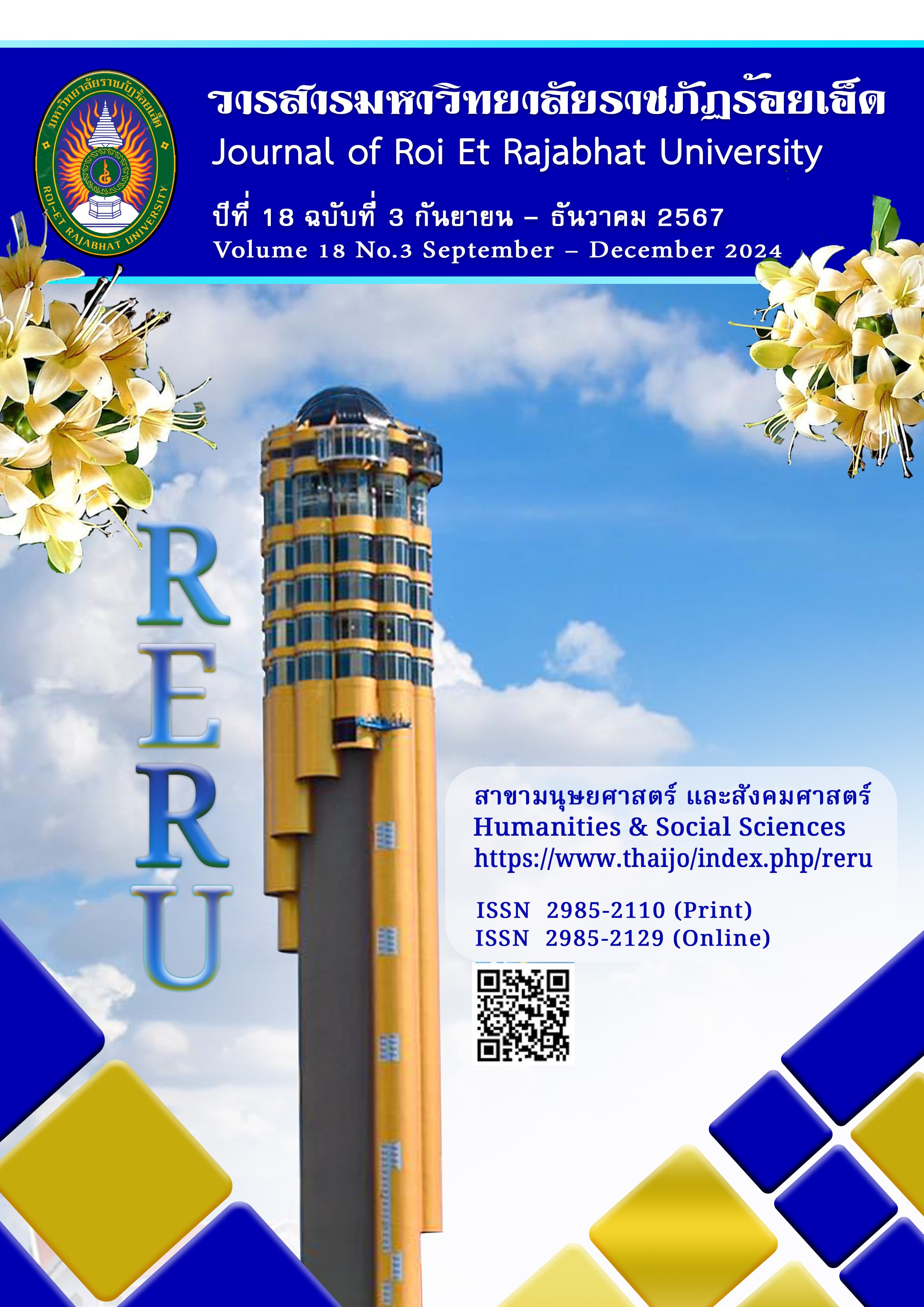From Thai Words to English Verses: An Analysis of Translation Strategies and Rhymes in Three Man Down’s Songs
Keywords:
Translation strategies, RhymesAbstract
As music is part of our lives and spreads its reach around the world, the translation of song lyrics plays a significant role in transferring key messages of artists to audiences speaking different languages. Simultaneously, translators are able to include linguistic features in translated lyrics for enhancement purposes. This research thus analyzed strategies applied to the Thai-English translation and rhymes used in the English translations of Thai songs of “Three Man Down” — a Thai musical band whose songs are well-known in several countries for their heart-breaking songs. According to the theory of Vinay and Darbelnet (2000), translation strategies found in the selected songs were mostly oblique ones (modulation, transposition, adaptation, and equivalence). The analysis of position-based rhymes using Pinsky’s (1998) theory, on the other hand, suggested the significantly frequent use of end rhymes in the songs. The scrutiny further revealed that adherence to the structure of the source language (herein Thai) was not necessary in translation of Three Man Down’s songs, as evidenced by multiple adjustments to the lyrics and occurrences of rhymes more frequently found in obliquely-translated lyrics than literally-translated ones.
References
Abdelaal, N. M. (2019). Subtitling of culture-bound terms: Strategies and quality assessment. Heliyon, 5(4), 1-27.
Anglia, N. (2020). The importance of music in education. Retrieved September 24, 2024, from https://www.nordangliaeducation.com/news/2020/07/06/the-importance-of-music-in-education
DeAngelis, T. (2020). Music’s power over our brains. APA Monitor on Psychology, 51(8). Retrieved September 24,
, from https://www.apa.org/monitor/2020/11/news-music-power
Fitri, A., Dewi, H. and Hidayat, R. S. (2022). The quality of rhyme and rhythm in song lyrics translation.
Paradigm of the Journal of Cultural Studies, 21(2), 213-227.
González, M. G. S. (2021). The importance of song lyrics in perceptions and the sense of identity of young people.
RES Journal of Social Education, 32, 413-423.
Gottlieb, H. (1992). Subtitles - a new university discipline. In C. Dollerup & A. Loddegaard (Eds.), Teaching translation and interpreting: training, talent, and experience (161-170). Amsterdam: John Benjamins.
Halimah, H. and Nuryanti, A. (2023). Translation method and category shift in Indonesian song lyrics covered to English. JOEL Journal of Educational and Language Research, 2(12), 1343-1362.
Hollander, J. (2014). Rhyme's reason: A guide to English verse (4th ed.). London: Yale University Press.
Jiemsak, R. and Jiemsak, N. (2022). The analysis of translation strategies on Thai country songs with critical thinking in the 21st century. 2022 7th International STEM Education Conference (iSTEM-Ed), Sukhothai, Thailand.
McCrary, J. M., Altenmüller, E., Kretschmer, C. and Scholz, D. S. (2022). Association of music interventions with health-related quality of life: A systematic review and meta-analysis. JAMA Netw Open, 5(3), 1-15.
McLaughlin, T. (1990). Figurative language. In F. Lentricchia and T. Mclaughlin (Eds.), Critical terms for literary study. (pp. 80-90). Illinois: The University of Chicago.
Miles, M. B. and Huberman, A. M. (1994). Qualitative data analysis: An expanded sourcebook (2nd ed.). California: Sage Publication.
Nasir, K., Nadia, S. and Nindia, A. (2022). An analysis of referential cohesive devices used in songs written by "Maher Zain". International Journal of Linguistics and Literature, 2(2), 167-176.
Newmark, P. (1988). A textbook of translation. New Jersey: Prentice Hall.
Pedersen, J. (2011). Subtitling norms for television: An exploration focusing on extralinguistic cultural references. Amsterdam: John Benjamins.
Pinsky, R. (1998). The sounds of poetry: A brief guide. New York: Straus and Giroux.
Robinson, P. (2018). The sound and sense of poetry. New York: Cambridge University Press.
Three Man Down. (2022). น้อง [Song]. On 28. GeneLab.
Three Man Down. (2023). เปิดตัวเขา [Song]. On 28. GeneLab.
Three Man Down. (2023). ไหนบอกเลิกแล้ว [Song]. GeneLab.
Three Man Down. (2024). ไม่ให้ไป [Song]. GeneLab.
Timyam, N. (2015). A comparative study of English and Thai: An introduction. Bangkok: Kasetsart University.
Timyam, N. (2010). An introduction to English linguistics. Bangkok: Thailand Research Fund.
Trichomwaree, P. (2015). A stylistic analysis in selected popular song lyrics of OASIS during 1994-1997. Retrieved September 24, 2024, from https://ethesisarchive.library.tu.ac.th/thesis/2015/TU_2015_5621030625_4804_2948.pdf
Vigl, J., Ojell-Järventausta, M., Sipola, H. and Saarikallio, S. (2023). Melody for the mind: Enhancing mood, motivation, concentration and learning through music listening in the classroom. Music & Science, Volume 6, 1-13.
Vinay, J. P. and Darbelnet, J. (2000). Comparative stylistics of French and English: A methodology for translation. John Benjamins.
Wilawan, S. (2020). The basic essentials of translation. Department of Foreign Languages, Faculty of Humanities, Kasetsart University.
Downloads
Published
How to Cite
Issue
Section
License
Copyright (c) 2024 Roi Et Rajabhat University

This work is licensed under a Creative Commons Attribution-NonCommercial-NoDerivatives 4.0 International License.
บทความที่ได้รับการตีพิมพ์เป็นลิขสิทธิ์ของวารสารมหาวิทยาลัยราชภัฎร้อยเอ็ด
ข้อความที่ปรากฏในบทความแต่ละเรื่องในวารสารวิชาการเล่มนี้เป็นความคิดเห็นส่วนตัวของผู้เขียนแต่ละท่านไม่เกี่ยวข้องกับมหาวิทยาลัยราชภัฎร้อยเอ็ด และคณาจารย์ท่านอื่นๆในมหาวิทยาลัยฯ แต่อย่างใด ความรับผิดชอบองค์ประกอบทั้งหมดของบทความแต่ละเรื่องเป็นของผู้เขียนแต่ละท่าน หากมีความผิดพลาดใดๆ ผู้เขียนแต่ละท่านจะรับผิดชอบบทความของตนเองแต่ผู้เดียว





